Pollution Indexing and Health Risk Assessment of Heavy-Metals-Laden Indoor and Outdoor Dust in Elementary School Environments in Riyadh, Saudi Arabia
Abstract
:1. Introduction
2. Materials and Methods
2.1. Dust Samples Collection and Analyses
2.2. Evaluation of HM Contamination Levels
2.3. Risk Assessment
2.3.1. Exposure Assessment
2.3.2. Non-Cancer Risk Assessment
2.3.3. Cancer Risk Assessment
3. Results and Discussion
3.1. Heavy Metals Content in Outdoor and Indoor Dust Samples
3.2. Pollution and Ecological Indices of Heavy Metals in Dust Samples
3.3. Human Health Risk Assessment of Heavy Metals of Dust in Outdoor and Indoor Areas
3.3.1. Non-Carcinogenic Hazard
3.3.2. Carcinogenic Risk
4. Conclusions
Supplementary Materials
Author Contributions
Funding
Institutional Review Board Statement
Informed Consent Statement
Data Availability Statement
Acknowledgments
Conflicts of Interest
References
- Joshi, U.M.; Vijayaraghavan, K.; Balasubramanian, R. Elemental composition of urban street dusts and their dissolution characteristics in various aqueous media. Chemosphere 2009, 77, 526–533. [Google Scholar] [CrossRef] [PubMed]
- Rodríguez, M.C.; Dupont-Courtade, L.; Oueslati, W. Air pollution and urban structure linkages: Evidence from European cities. Renew. Sustain. Energy Rev. 2016, 53, 1–9. [Google Scholar] [CrossRef]
- Jang, E.; Do, W.; Park, G.; Kim, M.; Yoo, E. Spatial and temporal variation of urban air pollutants and their concentrations in relation to meteorological conditions at four sites in Busan, South Korea. Atmos. Poll. Res. 2017, 8, 89–100. [Google Scholar] [CrossRef]
- Meuser, H. Contaminated Urban Soils; Springer Science and Business Media: Berlin/Heidelberg, Germany, 2010; Volume 18. [Google Scholar]
- Lenart-Boroń, A.; Boroń, P. The effect of industrial heavy metal pollution on microbial abundance and diversity in soils-a review. In Environmental Risk Assessment of Soil Contamination; InTech: London, UK, 2014. [Google Scholar]
- Alloway, B.J. Heavy Metals in Soil: Trace Metals and Metalloids in Soil and Their Bioavailability; Springer: Reading, UK, 2012. [Google Scholar]
- Ogunkunle, C.O.; Ziyath, A.; Opeloyeru, N.; Adeniyi, S.; Fatoba, P. Sources, Transport Pathways and the Ecological Risks of Heavy Metals Present in the Roadside Soil Environment in Urban Areas. Environ. Res. Eng. Manag. 2017, 73, 21–31. [Google Scholar] [CrossRef]
- Li, K.; Cui, S.; Zhang, F.; Hough, R.; Fu, Q.; Zhang, Z.; Gao, S.; An, L. Concentrations, Possible Sources and Health Risk of Heavy Metals in Multi-Media Environment of the Songhua River, China. Int. J. Environ. Res. Public Health 2020, 17, 1766. [Google Scholar] [CrossRef] [PubMed] [Green Version]
- Chithra, V.S.; Nagendra, S.S. Indoor air quality investigations in a naturally ventilated school building located close to an urban roadway in Chennai, India. Build. Environ. 2012, 54, 159–167. [Google Scholar] [CrossRef]
- Chen, R.; Zhou, B.; Kan, H.; Zhao, B. Associations of particulate air pollution and daily mortality in 16 Chinese cities: An improved effect estimate after accounting for the indoor exposure to particles of outdoor origin. Environ. Pollut. 2013, 182, 278–282. [Google Scholar] [CrossRef]
- Mohammadyan, M.; Alizadeh-Larimi, A.; Etemadinejad, S.; Latif, M.T.; Heibati, B.; Yetilmezsoy, K.; Abdul-Wahab, S.A.; Dadvand, P. Particulate air pollution at schools: Indoor-outdoor relationship and determinants of indoor concentrations. Aerosol. Air Qual. Res. 2017, 17, 857–864. [Google Scholar] [CrossRef]
- Meza-Figueroa, D.; De la O-Villanueva, M.; De la Parra, M.L. Heavy metal distribution in dust from elementary schools in Hermosillo, Sonora, México. Atmos. Environ. 2007, 41, 276–288. [Google Scholar] [CrossRef]
- Guo, H.; Morawska, L.; He, C.; Zhang, Y.L.; Ayoko, G.; Cao, M. Characterization of particle number concentrations and PM 2.5 in a school: Influence of outdoor air pollution on indoor air. Environ. Sci. Pollut. Res. 2010, 17, 1268–1278. [Google Scholar] [CrossRef] [Green Version]
- Al-Tayeb, N.T.; Jarar, B.M. Dusfall in the city of Ritadh. In Proceedings of the Industrial Air Pollution Symposium, Riyadh, Saudi Arabia, 15–17 November 1993; pp. 66–74. [Google Scholar]
- Al-Rajhi, M.A.; Seaward, M.R.D.; Al-Aamer, A.S. Metal levels in indoor and outdoor dust in Riyadh, Saudi Arabia. Environ. Int. 1996, 22, 315–324. [Google Scholar] [CrossRef]
- El-Desoky, G.E.; Aboul-Soud, M.A.; Al-Othman, Z.A.; Habila, M.; Giesy, J.P. Seasonal concentrations of lead in outdoor and indoor dust and blood of children in Riyadh, Saudi Arabia. Environ. Geochem. Health 2014, 36, 583–593. [Google Scholar] [CrossRef] [PubMed]
- Centers for Disease Control and Prevention. Low-Level Lead Exposure Harms Children: A Renewed Call of Primary Prevention. 2012. Available online: https://www.cdc.gov/nceh/lead/acclpp/final_document_030712.pdf (accessed on 10 January 2022).
- Centers for Disease Control and Prevention. Blood Lead Reference Value. 2021. Available online: https://www.cdc.gov/nceh/lead/data/blood-leadreference-value.htm (accessed on 12 January 2022).
- Praveena, S.M.; Abdul Mutalib, N.S.; Aris, A.Z. Determination of heavy metals in indoor dust from primary school (Sri Serdang, Malaysia): Estimation of the health risks. Environ. Forensics 2015, 16, 257–263. [Google Scholar] [CrossRef]
- Rehman, A.; Liu, G.; Yousaf, B.; Zia-ur-Rehman, M.; Ali, M.U.; Rashid, M.S.; Farooq, M.R.; Javed, Z. Characterizing pollution indices and children health risk assessment of potentially toxic metal(oid) s in school dust of Lahore, Pakistan. Ecotoxicol. Environ. Saf. 2020, 190, 110059. [Google Scholar] [CrossRef] [PubMed]
- Kampa, M.; Castanas, E. Human health effects of air pollution. Environ. Pollut. 2008, 151, 362–367. [Google Scholar] [CrossRef]
- Rodrigues, S.M.; Römkens, P.F. Human Health Risks and Soil Pollution. In Soil Pollution; Academic Press: Cambridge, MA, USA, 2018; pp. 217–250. [Google Scholar]
- Kim, Y.H.; Chung, D.H.; Cho, K.S. Contamination characteristics of heavy metals in indoor, outdoor and playground of schools in the Gochang-Gun, Chonbuk Province of South Korea. J. Korean Earth Sci. Soc. 2006, 27, 73–82. [Google Scholar]
- General Authority for Statistics. Statical Yearbook, Saudi Arabia. 2010. Available online: http://cutt.us/RYQBp (accessed on 22 December 2021).
- USEPA. Methods 3051, Micro-wave Assisted Acid Digestion of sediments, Sluges, Soil and Oils. In Test Methods for Evaluating Solid Waste, Physical/Chemical Methods, 3rd ed.; U.S. Environmental Protection Agency: Washington, DC, USA, 1994. [Google Scholar]
- Chen, T.B.; Zheng, Y.M.; Lei, M.; Huang, Z.C.; Wu, H.T.; Chen, H.; Tian, Q.Z. Assessment of heavy metal pollution in surface soils of urban parks in Beijing, China. Chemosphere 2005, 60, 542–551. [Google Scholar] [CrossRef]
- Wang, L.; Lu, X.; Ren, C.; Li, X.; Chen, C. Contamination assessment and health risk of heavy metals in dust from Changqing industrial park of Baoji, NW China. Environ. Earth Sci. 2014, 71, 2095–2104. [Google Scholar] [CrossRef]
- Turekian, K.K.; Wedepohl, K.H. Distribution of the metals in some major units of the earth’s crust. Geol. Soc. Am. Bull. 1961, 72, 175–192. [Google Scholar] [CrossRef]
- Hakanson, L. An ecological risk index for aquatic pollution control. A sediment logical approach. Water Res. 1980, 14, 75–1001. [Google Scholar] [CrossRef]
- Sutherland, R.A.; Tack, F.M.G.; Tolosa, C.A.; Verloo, M.G. Operationally defined metal fractions in road deposited sediment, Honolulu, Hawaii. J. Environ. Qual. 2000, 29, 1431–1439. [Google Scholar] [CrossRef]
- USEPA. Integrated Risk Information System (IRIS); U.S. Environmental Protection Agency: Washington, DC, USA, 2011.
- Luo, X.S.; Ding, J.; Xu, B.; Wang, Y.J.; Li, H.B.; Yu, S. Incorporating bioaccessibility into human health risk assessments of heavy metals in urban park soils. Sci. Total Environ. 2012, 424, 88–96. [Google Scholar] [CrossRef] [PubMed]
- Ferreira-Baptista, L.; De Miguel, E. Geochemistry and risk assessment of street dust in Luanda, Angola: A tropical urban environment. Atmos. Environ. 2005, 39, 4501–4512. [Google Scholar] [CrossRef] [Green Version]
- USDOE. The Risk Assessment Information System (RAIS); U.S. Department of Energy’s Oak Ridge Operations Office (ORO): Oak Ridge, TN, USA, 2011.
- Al-Khashman, O.A. Determination of metal accumulation in deposited street dusts in Amman, Jordan. Environ. Geochem. Health 2007, 29, 1–10. [Google Scholar] [CrossRef] [PubMed]
- Apeagyei, E.; Bank, M.S.; Spengler, J.D. Distribution of heavy metals in road dust along an urban-rural gradient in Massachusetts. Atmos. Environ. 2011, 45, 2310–2323. [Google Scholar] [CrossRef]
- Cao, Z.; Yang, Y.; Lu, J.; Zhang, C. Atmospheric particle characterization, distribution, and deposition in Xi’an, Shaanxi Province, Central China. Environ. Pollut. 2011, 159, 577–584. [Google Scholar] [CrossRef]
- Yeung, Z.L.L.; Kwok, R.C.W.; Yu, K.N. Determination of multi-element profiles of street dust using energy dispersive X-ray fluorescence (EDXRF). Appl. Radiat. Isot. 2003, 58, 339–346. [Google Scholar] [CrossRef] [Green Version]
- Fergusson, J.E.; Ryan, D.E. The elemental composition of street dust from large and small urban areas related to city type, source and particle size. Sci. Total Environ. 1984, 34, 101–116. [Google Scholar] [CrossRef]
- De Miguel, E.; Llamas, J.F.; Chacón, E.; Berg, T.; Larssen, S.; Røyset, O.; Vadset, M. Origin and patterns of distribution of trace elements in street dust: Unleaded petrol and urban lead. Atmos. Environ. 1997, 31, 2733–2740. [Google Scholar] [CrossRef]
- Rasmussen, P.E.; Subramanian, K.S.; Jessiman, B.J. A multi-element profile of house dust in relation to exterior dust and soils in the city of Ottawa, Canada. Sci. Total Environ. 2001, 267, 125–140. [Google Scholar] [CrossRef]
- Othman, M.; Latif, M.T.; Mohamed, A.F. Health impact assessment from building life cycles and trace metals in coarse particulate matter in urban office environments. Ecotoxicol. Environ. Saf. 2018, 148, 293–302. [Google Scholar] [CrossRef] [PubMed]
- Cao, S.; Chen, X.; Zhang, L.; Xing, X.; Wen, D.; Wang, B.; Duan, X. Quantificational exposure, sources, and health risks posed by heavy metals in indoor and outdoor household dust in a typical smelting area in China. Indoor Air 2020, 30, 872–884. [Google Scholar] [CrossRef] [PubMed]
- Goyal, R.; Khare, M. Indoor–outdoor concentrations of RSPM in classroom of a naturally ventilated school building near an urban traffic roadway. Atmos. Environ. 2009, 43, 6026–6038. [Google Scholar] [CrossRef]
- Yongming, H.; Peixuan, D.; Junji, C.; Posmentier, E.S. Multivariate analysis of heavy metal contamination in urban dusts of Xi’an, Central China. Sci. Total Environ. 2006, 355, 176–186. [Google Scholar] [CrossRef] [PubMed]
- Ye, C.; Li, S.; Zhang, Y.; Zhang, Q. Assessing soil heavy metal pollution in the water-level-fluctuation zone of the Three Gorges Reservoir, China. J. Hazard. Mater. 2011, 191, 366–372. [Google Scholar] [CrossRef]
- Kowalska, J.B.; Mazurek, R.; Gąsiorek, M.; Zaleski, T. Pollution indices as useful tools for the comprehensive evaluation of the degree of soil contamination–A review. Environ. Geochem. Health 2018, 40, 2395–2420. [Google Scholar] [CrossRef] [Green Version]
- USEPA. Exposure and Human Health Reassessment of 2,3,7,8-Tetrachlorodibenzo-p-dioxin and Related Compounds. National Academy of Sciences Review Draft; National Center for Environmental Assessment, Office of Research and Development: Washington, DC, USA, 2004. Available online: http://cutt.us/W0CGV (accessed on 16 November 2021).
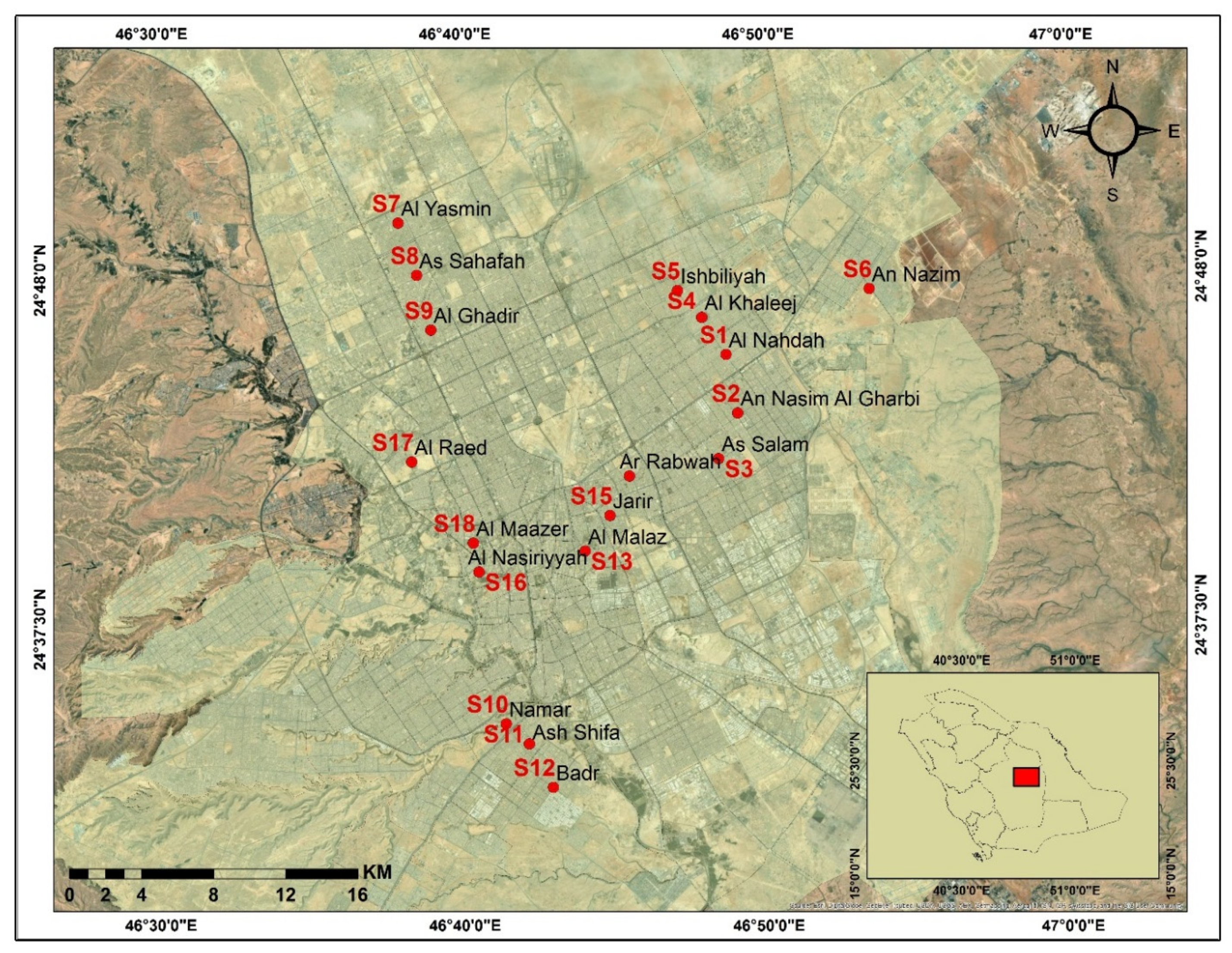
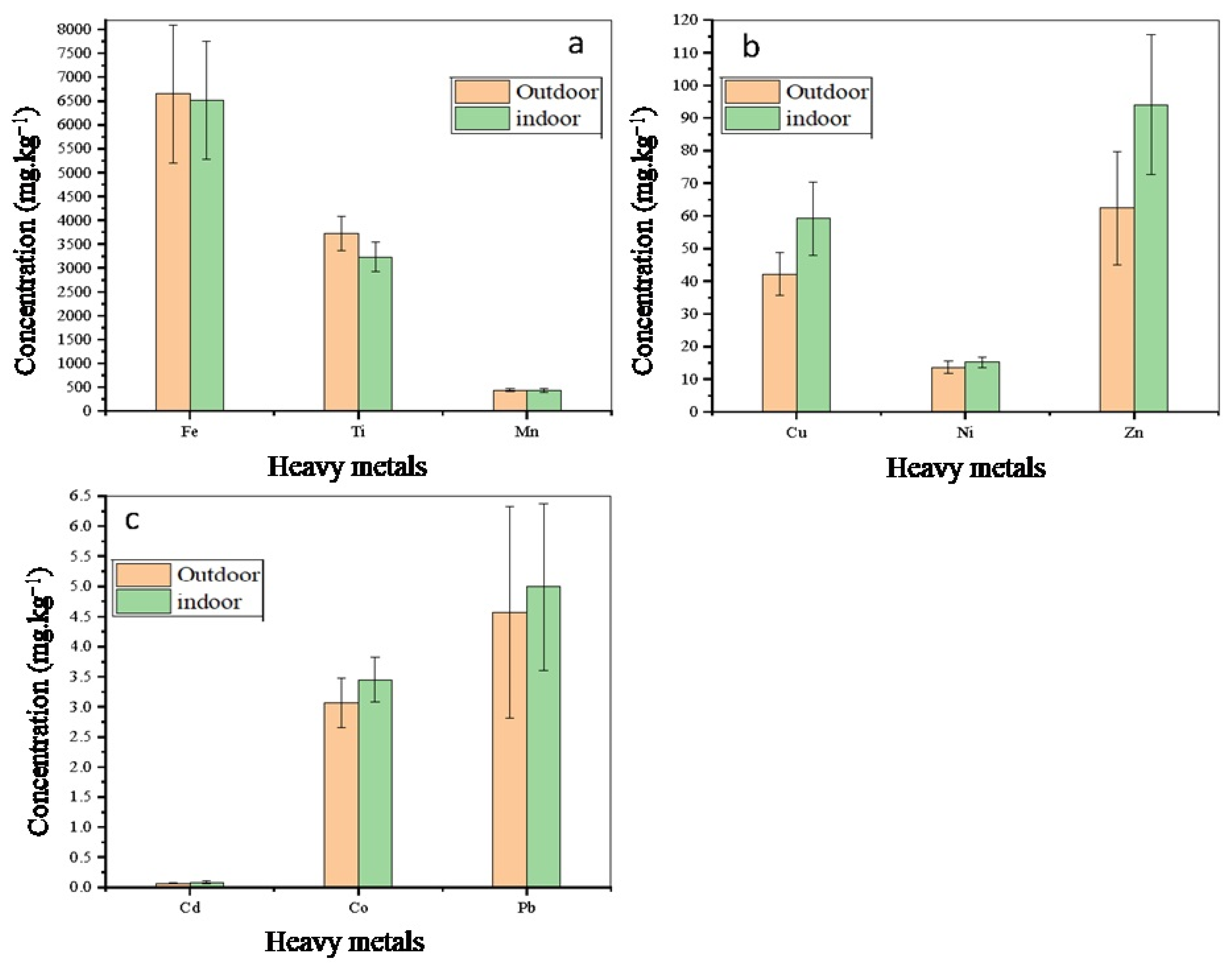

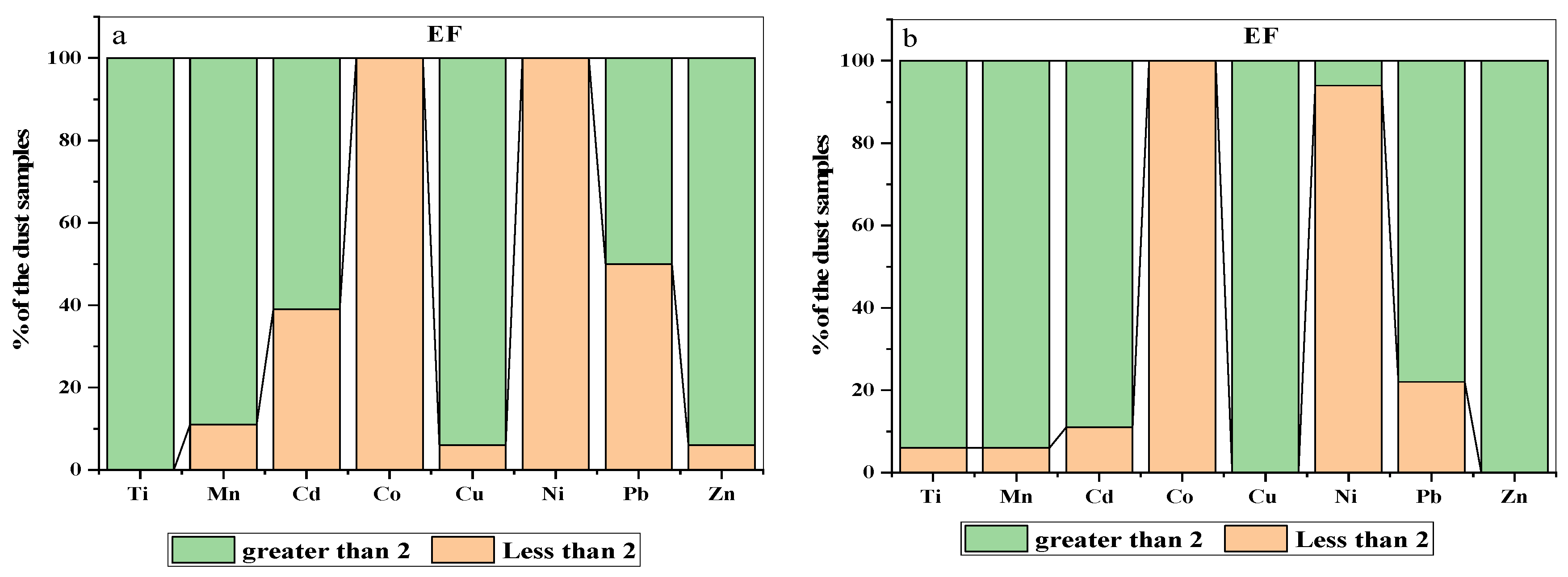
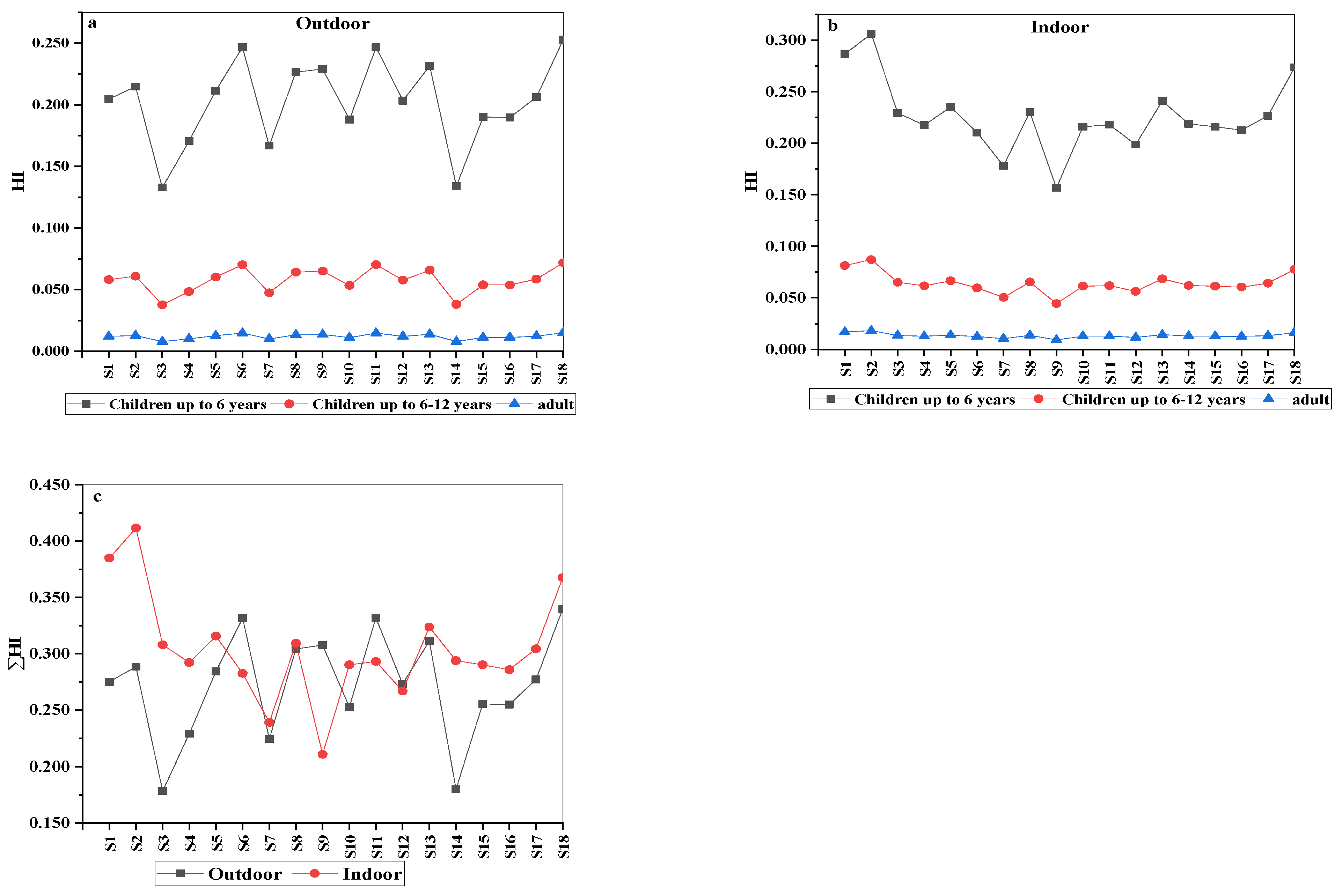
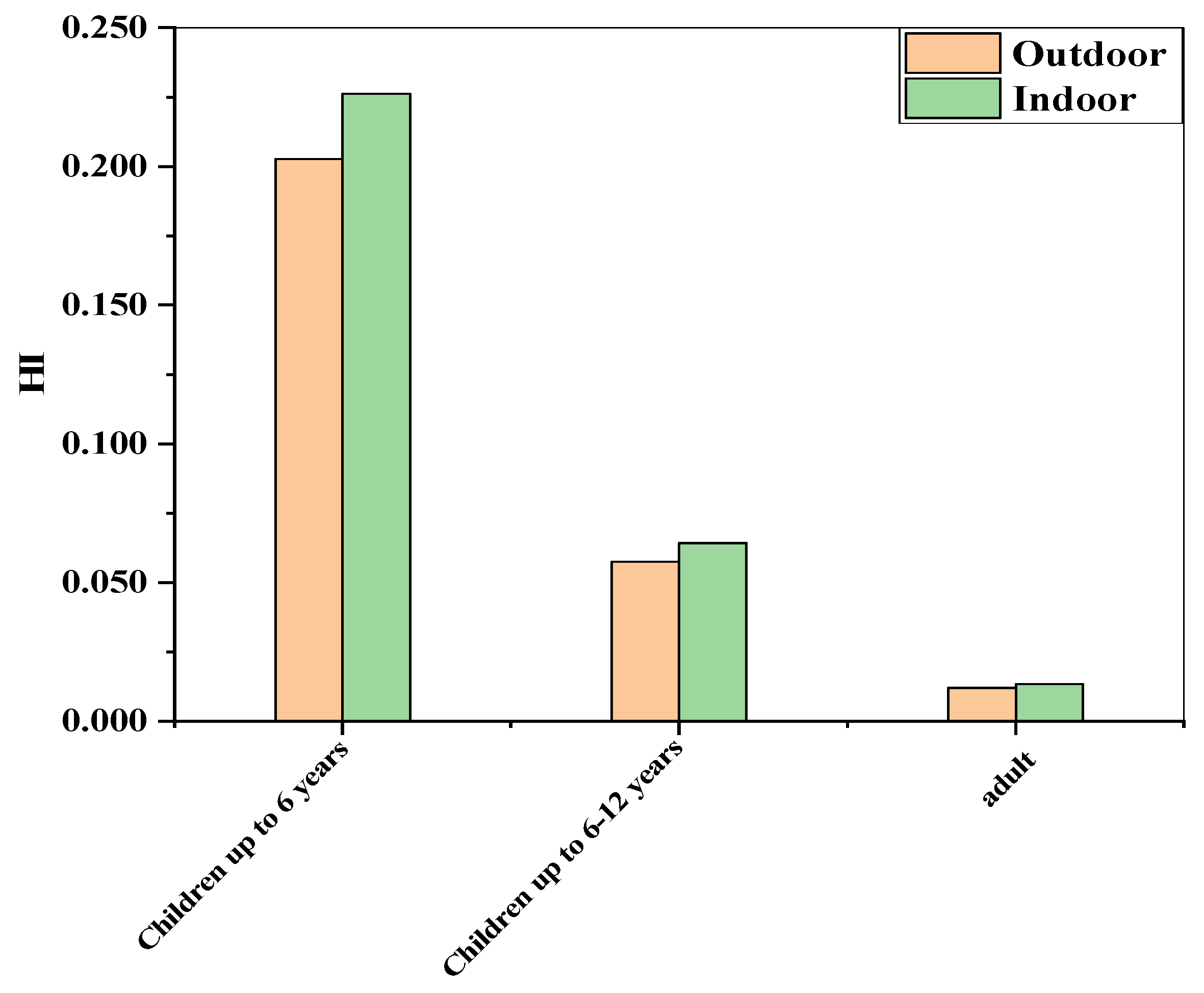
| Variable | Unit | Definition | Value | References |
|---|---|---|---|---|
| ADDingestion ADDdermal | mg kg−1 day−1 | The average daily dose contacted through ingestion and dermal | In this study | |
| Cdust | mg kg−1 | Concentration of metal in dust | In this study | |
| IRingestion | mg day−1 | The ingestion rate of dust | 200 for children up to 6 years, 100 for children 6–12 years, and 50 for adult | [4] |
| EF | day | The exposure frequency | 350 | [31] |
| ED | year | The exposure duration | 5 years for children up to 6 years, 6 years for children 6–12 years, and 58 for adult | [4] |
| F | unitless | Factor = 10−6 | [31] | |
| ABS | unitless | the dermal absorption factor | 0.03 for AS and 0.001 for other metals | [31,32,33] |
| BW | kg | average body weight | 16 kg for children up to 6 years, 29 kg from 6 –12 years, and 70 for adult | [4] |
| AT | day | average lifetime | For non-carcinogenic = ED × 365 5 × 365 for children up to 6 years, 5 × 365 for children 6–12 years, and 58 × 365 for adult. For carcinogenic, 70 × 365 for 3 age categories | [4] |
| SA | cm2 | the exposed skin surface area | 6980 for children up to 6 years, 10,470 for children 6–12 years, and 18,150 for adult | [4] |
| RFDingestion | mg kg−1 day−1 | Chronic oral reference dose | Cd = 0.001; Co = 3.00 × 10−4; Cr = 3.00 × 10−3; Cu = 4.00 × 10−2; Mn = 1.40 × 10−2; Ni = 2.00 × 10−2; Pb = 3.50 × 10−3; Zn = 3.00 × 10−1 | [34] |
| RFDdermal | mg kg−1 day−1 | Chronic dermal reference dose | Co = 1.60 × 10−2; Cr = 6.00 × 10−5; Cu = 1.20 × 10−2; Cd = 2.50 × 10−5 (Luo et al., 2012); Mn = 1.84 × 10−3; Ni = 5.40 × 10−3; Pb = 3.25 × 10−4; Zn = 6.00 × 10−2 | [31,34] |
| SFing | Cancer slope factor | Cr = 5.00 × 10−1; Pb = 8.5 × 10−3 | [32,34] | |
| SFder | Cancer slope factore | Cr = 6.50 × 10−3; Pb = 8.50 × 10−3 | [31,32,34] |
| Fe | Ti | Mn | Cd | Co | Cu | Ni | Pb | Zn | Fe | Ti | Mn | Cd | Co | Cu | Ni | Pb | Zn | |||
|---|---|---|---|---|---|---|---|---|---|---|---|---|---|---|---|---|---|---|---|---|
| Outdoor dust | Indoor dust | |||||||||||||||||||
| Pollution index | ||||||||||||||||||||
| Pollution index | IPI | Pollution index | IPI | |||||||||||||||||
| Max | 0.3 | 0.9 | 0.6 | 0.5 | 0.1 | 1.2 | 0.2 | 0.9 | 2.1 | 0.5 | 0.3 | 0.7 | 0.7 | 1 | 0.1 | 1.5 | 0.2 | 0.8 | 2.7 | 0.7 |
| Min | 0.1 | 0.4 | 0.3 | 0.2 | 0 | 0.4 | 0.1 | 0 | 0.4 | 0.3 | 0.1 | 0.3 | 0.4 | 0.2 | 0.1 | 0.5 | 0.1 | 0.2 | 0.6 | 0.3 |
| Average | 0.13 | 0.62 | 0.49 | 0.33 | 0.08 | 0.6 | 0.14 | 0.29 | 0.78 | 0.38 | 0.1 | 0.5 | 0.5 | 0.4 | 0.1 | 0.9 | 0.2 | 0.3 | 1.18 | 0.5 |
| Geo−accumulation index | ||||||||||||||||||||
| Max | −2 | 0 | −1 | −2 | −3 | 0 | −2 | −1 | 2 | – | −2 | −1 | −1 | −1 | −3 | 1 | −2 | −1 | 3 | – |
| Min | −4 | −1 | −2 | −4 | −4 | −1 | −4 | −7 | 0 | – | −4 | −2 | −2 | −4 | −4 | −1 | −3 | −3 | 1 | – |
| Average | −3 | −1 | −2 | −3 | −3 | −1 | −3 | −3 | 1 | – | −4 | −1 | −2 | −3 | −3 | 0 | −3 | −3 | 2 | – |
| Enrichment factor | ||||||||||||||||||||
| Max | – | 6.3 | 6.1 | 5.3 | 0.9 | 9.7 | 1.6 | 6.7 | 15 | – | – | 5.9 | 5.6 | 7.9 | 1.1 | 12 | 2 | 6.3 | 15 | – |
| Min | – | 2.9 | 1.4 | 1.4 | 0.4 | 1.4 | 0.6 | 0.05 | 1.8 | – | – | 1.9 | 1.7 | 1.4 | 0.3 | 4.2 | 0.6 | 0.7 | 4.4 | – |
| Average | – | 5 | 4.1 | 2.7 | 0.6 | 5 | 1.1 | 2.3 | 6.4 | – | – | 4.5 | 4 | 3.3 | 0.7 | 6.8 | 1.3 | 2.6 | 9.4 | – |
| Ecological risk and integrated potential ecological risk | ||||||||||||||||||||
| Ei = Ti fi | RI | Ei = Ti fi | RI | |||||||||||||||||
| Max | – | – | – | – | 14.9 | 5.8 | 1 | 4.3 | 2.1 | 23.9 | – | – | – | 29.1 | 7.4 | 1.1 | 4.2 | 2.7 | 37.5 | – |
| Min | – | – | – | – | 4.6 | 2.1 | 0.4 | 0.1 | 0.4 | 8.6 | – | – | – | 5.5 | 2.4 | 0.5 | 0.9 | 0.6 | 11.8 | – |
| Average | – | – | – | – | 9.8 | 3 | 0.7 | 1.4 | 0.8 | 15.7 | – | – | – | 12 | 4.2 | 0.8 | 1.6 | 1.2 | 19.7 | – |
| Hazard Quotient (HQ) | ||||||||
|---|---|---|---|---|---|---|---|---|
| Mn | Cd | Co | Cu | Ni | Pb | Zn | ||
| Children up to 6 years | ||||||||
| HQing | Outdoor | 3.76 × 10−2 | 7.78 × 10−4 | 1.22 × 10−1 | 1.26 × 10−2 | 8.15 × 10−3 | 1.56 × 10−2 | 2.49 × 10−3 |
| Indoor | 3.70 × 10−2 | 9.57 × 10−4 | 1.37 × 10−1 | 1.77 × 10−2 | 9.10 × 10−3 | 1.70 × 10−2 | 3.75 × 10−3 | |
| HQder | Outdoor | 2.63 × 10−4 | 2.17 × 10−4 | 8.54 × 10−4 | 8.80 × 10−5 | 1.42 × 10−3 | 1.09 × 10−4 | 1.74 × 10−5 |
| Indoor | 2.58 × 10−4 | 2.67 × 10−4 | 9.58 × 10−4 | 1.23 × 10−4 | 1.59 × 10−3 | 1.19 × 10−4 | 2.62 × 10−5 | |
| Children 6–12 years | ||||||||
| HQing | Outdoor | 1.04 × 10−2 | 2.15 × 10−4 | 3.38 × 10−2 | 3.48 × 10−3 | 2.25 × 10−3 | 4.30 × 10−3 | 6.86 × 10−4 |
| Indoor | 1.02 × 10−2 | 2.64 × 10−4 | 3.79 × 10−2 | 4.88 × 10−3 | 2.51 × 10−3 | 4.70 × 10−3 | 1.03 × 10−3 | |
| HQder | Outdoor | 2.17 × 10−4 | 1.80 × 10−4 | 7.07 × 10−4 | 7.28 × 10−5 | 1.18 × 10−3 | 9.01 × 10−5 | 1.44 × 10−5 |
| Indoor | 2.14 × 10−4 | 2.21 × 10−4 | 7.93 × 10−4 | 1.02 × 10−4 | 1.31 × 10−3 | 9.84 × 10−5 | 2.17 × 10−5 | |
| Adult | ||||||||
| HQing | Outdoor | 2.15 × 10−3 | 4.45 × 10−5 | 6.99 × 10−3 | 7.21 × 10−4 | 4.66 × 10−4 | 8.92 × 10−4 | 1.42 × 10−4 |
| Indoor | 2.12 × 10−3 | 5.47 × 10−5 | 7.85 × 10−3 | 1.01 × 10−3 | 5.20 × 10−4 | 9.73 × 10−4 | 2.14 × 10−4 | |
| HQder | Outdoor | 5.46 × 10−5 | 4.52 × 10−5 | 1.78 × 10−4 | 1.83 × 10−5 | 2.96 × 10−4 | 2.27 × 10−5 | 3.61 × 10−6 |
| Indoor | 5.38 × 10−5 | 5.56 × 10−5 | 1.99 × 10−4 | 2.57 × 10−5 | 3.30 × 10−4 | 2.47 × 10−5 | 5.44 × 10−6 | |
| ∑ all categories | ||||||||
| HQing | Outdoor | 5.02 × 10−2 | 1.04 × 10−3 | 1.63 × 10−1 | 1.68 × 10−2 | 1.09 × 10−2 | 2.08 × 10−2 | 3.32 × 10−3 |
| Indoor | 4.94 × 10−2 | 1.28 × 10−3 | 1.83 × 10−1 | 2.36 × 10−2 | 1.21 × 10−2 | 2.27 × 10−2 | 5.00 × 10−3 | |
| HQder | Outdoor | 5.35 × 10−4 | 4.42 × 10−4 | 1.74 × 10−3 | 1.79 × 10−4 | 2.90 × 10−3 | 2.22 × 10−4 | 3.53 × 10−5 |
| Indoor | 5.26 × 10−4 | 5.44 × 10−4 | 1.95 × 10−3 | 2.51 × 10−4 | 3.23 × 10−3 | 2.42 × 10−4 | 5.33 × 10−5 | |
| Hazard Index (HI) | ||||||||
|---|---|---|---|---|---|---|---|---|
| Mn | Cd | Co | Cu | Ni | Pb | Zn | Sum | |
| Children up to 6 years | ||||||||
| Outdoor | 3.79 × 10−2 | 9.96 × 10−4 | 1.23 × 10−1 | 1.27 × 10−2 | 9.58 × 10−3 | 1.57 × 10−2 | 2.50 × 10−3 | 2.03 × 10−1 |
| Indoor | 3.73 × 10−2 | 1.22 × 10−3 | 1.38 × 10−1 | 1.78 × 10−2 | 1.07 × 10−2 | 1.72 × 10−2 | 3.78 × 10−3 | 2.26 × 10−1 |
| Children 6–12 years | ||||||||
| Outdoor | 1.06 × 10−2 | 3.95 × 10−4 | 3.45 × 10−2 | 3.55 × 10−3 | 3.43 × 10−3 | 4.39 × 10−3 | 7.01 × 10−4 | 5.75 × 10−2 |
| Indoor | 1.04 × 10−2 | 4.85 × 10−4 | 3.87 × 10−2 | 4.98 × 10−3 | 3.83 × 10−3 | 4.80 × 10−3 | 1.06 × 10−3 | 6.42 × 10−2 |
| Adult | ||||||||
| Outdoor | 2.20 × 10−3 | 8.97 × 10−5 | 7.17 × 10−3 | 7.39 × 10−4 | 7.62 × 10−4 | 9.14 × 10−4 | 1.46 × 10−4 | 1.20 × 10−2 |
| Indoor | 2.17 × 10−3 | 1.10 × 10−4 | 8.05 × 10−3 | 1.04 × 10−3 | 8.51 × 10−4 | 9.98 × 10−4 | 2.20 × 10−4 | 1.34 × 10−2 |
| Σ HI | RI + | IPI | EF + | Igeo + | |
|---|---|---|---|---|---|
| Σ HI | 1.00 | ||||
| RI + | 0.71 * | 1.00 | |||
| IPI | 0.60 * | 0.74 * | 1.00 | ||
| EF + | 0.30 | 0.40 * | 0.40 * | 1.00 | |
| Igeo + | 0.81 * | 0.82 * | 0.89 * | 0.40 * | 1.00 |
| Pb | |||||
|---|---|---|---|---|---|
| Children Up to 6 years | Children 6–12 Years | Adult | ∑ | ||
| ILCRing | Outdoor | 3.32 × 10−8 | 1.10 × 10−8 | 2.20 × 10−8 | 6.61 × 10−8 |
| Indoor | 3.62 × 10−8 | 1.20 × 10−8 | 2.40 × 10−8 | 7.22 × 10−8 | |
| ILCRder | Outdoor | 3.20 × 10−6 | 3.18 × 10−6 | 7.73 × 10−6 | 1.41 × 10−5 |
| Indoor | 3.50 × 10−6 | 3.47 × 10−6 | 8.44 × 10−6 | 1.54 × 10−5 | |
| ILCRing+der | Outdoor | 3.24 × 10−6 | 3.19 × 10−6 | 7.75 × 10−6 | 1.42 × 10−5 |
| Indoor | 3.53 × 10−6 | 3.48 × 10−6 | 8.46 × 10−6 | 1.55 × 10−5 | |
Publisher’s Note: MDPI stays neutral with regard to jurisdictional claims in published maps and institutional affiliations. |
© 2022 by the authors. Licensee MDPI, Basel, Switzerland. This article is an open access article distributed under the terms and conditions of the Creative Commons Attribution (CC BY) license (https://creativecommons.org/licenses/by/4.0/).
Share and Cite
Alotaibi, M.O.; Albedair, L.A.; Alotaibi, N.M.; Elobeid, M.M.; Al-Swadi, H.A.; Alasmary, Z.; Ahmad, M. Pollution Indexing and Health Risk Assessment of Heavy-Metals-Laden Indoor and Outdoor Dust in Elementary School Environments in Riyadh, Saudi Arabia. Atmosphere 2022, 13, 464. https://doi.org/10.3390/atmos13030464
Alotaibi MO, Albedair LA, Alotaibi NM, Elobeid MM, Al-Swadi HA, Alasmary Z, Ahmad M. Pollution Indexing and Health Risk Assessment of Heavy-Metals-Laden Indoor and Outdoor Dust in Elementary School Environments in Riyadh, Saudi Arabia. Atmosphere. 2022; 13(3):464. https://doi.org/10.3390/atmos13030464
Chicago/Turabian StyleAlotaibi, Modhi O., Lamia A. Albedair, Nahaa M. Alotaibi, Mudawi M. Elobeid, Hamed A. Al-Swadi, Zafer Alasmary, and Munir Ahmad. 2022. "Pollution Indexing and Health Risk Assessment of Heavy-Metals-Laden Indoor and Outdoor Dust in Elementary School Environments in Riyadh, Saudi Arabia" Atmosphere 13, no. 3: 464. https://doi.org/10.3390/atmos13030464
APA StyleAlotaibi, M. O., Albedair, L. A., Alotaibi, N. M., Elobeid, M. M., Al-Swadi, H. A., Alasmary, Z., & Ahmad, M. (2022). Pollution Indexing and Health Risk Assessment of Heavy-Metals-Laden Indoor and Outdoor Dust in Elementary School Environments in Riyadh, Saudi Arabia. Atmosphere, 13(3), 464. https://doi.org/10.3390/atmos13030464







